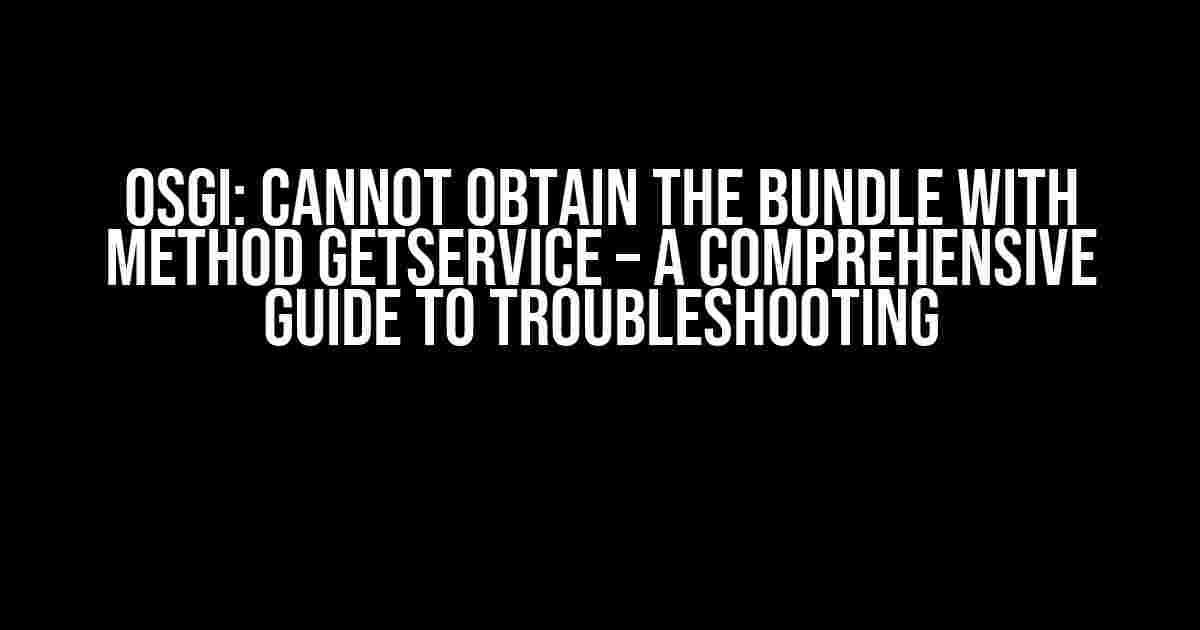Have you ever encountered the frustrating error “Cannot obtain the bundle with method getService” while working with OSGi? You’re not alone! In this article, we’ll delve into the world of OSGi and explore the possible causes and solutions to this common issue. Buckle up, and let’s get started!
What is OSGi, and what’s getService?
Before we dive into the error, let’s quickly cover the basics. OSGi (Open Service Gateway Initiative) is a modular framework for Java that allows developers to create, deploy, and manage modular applications.
getService is a fundamental method in OSGi that enables services to register themselves with the OSGi framework. When a service is registered, it can be accessed by other bundles (plug-ins) within the application using the getService method.
The Error: Cannot Obtain the Bundle with Method GetService
The error “Cannot obtain the bundle with method getService” typically occurs when the OSGi framework is unable to locate the required bundle or service. This can happen due to various reasons, which we’ll discuss in detail below.
Possible Causes:
Here are some common causes of the “Cannot obtain the bundle with method getService” error:
- Bundle Not Deployed or Activated: If the bundle containing the service is not properly deployed or activated, the OSGi framework won’t be able to locate it.
- Service Not Registered: If the service is not registered with the OSGi framework, it won’t be accessible using the getService method.
- Bundle Dependencies Not Met: If the bundle has dependencies that are not met, the OSGi framework might not be able to resolve the bundle, leading to the error.
- Classloading Issues: Classloading issues can cause the OSGi framework to fail in resolving the bundle or service.
- OSGi Configuration Issues: Misconfigured OSGi settings can prevent the framework from functioning correctly.
Troubleshooting Steps:
Now that we’ve identified the possible causes, let’s go through some troubleshooting steps to resolve the “Cannot obtain the bundle with method getService” error:
- Verify Bundle Deployment and Activation: Ensure that the bundle containing the service is properly deployed and activated. Check the OSGi console or the relevant logs to confirm.
- Check Service Registration: Verify that the service is registered with the OSGi framework using the correct interface and class.
- Resolve Bundle Dependencies: Ensure that all bundle dependencies are met by checking the MANIFEST.MF file or the OSGi console.
- Check Classloading: Verify that the required classes are loaded correctly by checking the classpath and ensuring that there are no conflicts.
- Review OSGi Configuration: Check the OSGi configuration files (e.g., config.ini) to ensure that the settings are correct and up-to-date.
Advanced Troubleshooting Techniques:
In some cases, the error might persist even after following the above steps. Here are some advanced techniques to help you debugging:
Using the OSGi Console:
The OSGi console provides a wealth of information about the bundles, services, and configuration. You can use the console to:
- Check the bundle status (installed, started, or activated)
- Verify service registrations
- Check bundle dependencies and resolutions
- Inspect configuration settings
-> osgi ls -> osgi services -> osgi bundles -> osgi config
Enabling Debug Logging:
Enabling debug logging for the OSGi framework can provide valuable insights into the error. You can enable debug logging by setting the following properties:
<property name="org.osgi.framework.log.level" value="DEBUG"/> <property name="org.osgi.service.log.level" value="DEBUG"/>
This will log detailed information about the OSGi framework, services, and bundles, which can help identify the root cause of the error.
Using a Bundle Tracker:
A bundle tracker is a tool that helps track the state of bundles and services in the OSGi framework. You can use a bundle tracker to:
- Monitor bundle states (installing, resolving, starting, etc.)
- Track service registrations and unregistrations
- Identify potential issues with bundle dependencies
There are several bundle trackers available, such as the Apache Felix Bundle Tracker or the Eclipse OSGi Console.
Conclusion:
The “Cannot obtain the bundle with method getService” error in OSGi can be frustrating, but with the right troubleshooting techniques, you can identify and resolve the issue. By following the steps outlined in this article, you’ll be well on your way to resolving the error and getting your OSGi application up and running smoothly.
| Error Cause | Solution |
|---|---|
| Bundle Not Deployed or Activated | Verify bundle deployment and activation |
| Service Not Registered | Verify service registration |
| Bundle Dependencies Not Met | Resolve bundle dependencies |
| Classloading Issues | Check classloading and ensure correct classpath |
| OSGi Configuration Issues | Review OSGi configuration and ensure correct settings |
Remember, troubleshooting OSGi errors requires patience, persistence, and a systematic approach. By following the steps outlined in this article, you’ll be able to troubleshoot and resolve the “Cannot obtain the bundle with method getService” error and get back to developing your OSGi application with confidence.
Frequently Asked Question
Stuck with OSGi and its bundle woes? Fret not, we’ve got you covered! Here are some frequently asked questions about OSGi and the pesky “cannot obtain the bundle with method getService” error.
Why does OSGi fail to obtain the bundle with the getService method?
This error usually occurs when the bundle is not in the ACTIVE state or is not registered as a service. Make sure the bundle is properly installed, started, and registered as a service. You can check the bundle’s state using the OSGi console or a tool like Apache Felix Web Console.
How do I troubleshoot the “cannot obtain the bundle” error in OSGi?
To troubleshoot this error, check the OSGi console logs for any errors or warnings related to the bundle. You can also use the OSGi console command `bundles` to list all installed bundles and their states. Additionally, verify that the bundle’s dependencies are correctly resolved and that it’s not conflicting with other bundles.
What are the common reasons for a bundle to not be in the ACTIVE state?
Common reasons for a bundle not being in the ACTIVE state include: unresolved dependencies, incorrect bundle dependencies, incorrect bundle version, or conflicts with other bundles. Check the bundle’s manifest file and dependencies to ensure everything is correctly configured.
Can I use the OSGi console to debug the “cannot obtain the bundle” error?
Yes, the OSGi console provides various commands to help debug the error. Use the `diag` command to diagnose bundle-related issues, `bundle` command to inspect bundle details, and `services` command to verify service registrations. These commands can help you identify the root cause of the error.
Are there any best practices to avoid the “cannot obtain the bundle” error in OSGi?
Yes, follow these best practices to avoid the error: ensure correct bundle dependencies, use version ranges for dependencies, use the `Require-Bundle` header instead of `Import-Package`, and test your bundles in a controlled environment before deploying them to production.


